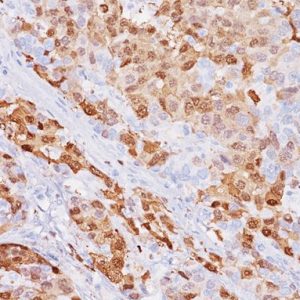Description
Kappa and Lambda antibodies are usually run together on two separate tissues. In normal tissue, the Kappa and Lambda cell ratio is approximately 2:1. The double stain antibody allows the investigator to simultaneously see both Kappa (M) (brown) and Lambda (P) (red) on the same tissue section, thus allowing the end-user a more accurate and easier assessment of both stains.
The antibody cocktail recognizes both Kappa and Lambda light chains. It is reportedly useful in the identification of myelomas, plasmacytomas, and certain non-Hodgkin’s lymphomas. The most common feature of these malignancies is the restricted expression of a single light chain class. Demonstration of clonality in lymphoid infiltrates may indicate that the infiltrate is malignant.
SPECIFICATIONS
Specifications
| INTENDED USE | IVD |
|---|---|
| FORMAT | Predilute, VALENT |
| VOLUME | 20 ml, 6.0 ml |
| SOURCE | Mouse Monoclonal, Rabbit Polyclonal |
| CLONE | L1C1, N/A |
| ISOTYPE | IgG, IgG1 |
| ANTIGEN | Kappa light chain, Lambda Light Chain |
| LOCALIZATION | Cytoplasmic |
| POSITIVE CONTROL | Tonsil or bone marrow |
| SPECIES REACTIVITY | Human; others not tested |
DATASHEETS & SDS
REFERENCES
1. Samoszuk MK, et al. Limitations of numerical ratios for defining monoclonality of immunoglobulin light chains in B-cell lymphomas. Diagn Immunol. 1985; 3(3):133-8.
2. Bray M, Alper MG. Lambda light chain predominance as a sign of emerging lymphoma. Am J Clin Pathol. 1983 Oct; 80(4):526-8.
3. Sobol RE, et al. Use of immunoglobulin light chain analysis to detect bone marrow involvement in B-cell neoplasms. Clin Immunol Immunopathol. 1982 Jul; 24(1):139 -44.
4. Falini B, et al. Double labeled-antigen method for demonstration of intracellular antigens in paraffin-embedded tissues. J Histochem Cytochem. 1982 Jan; 30(1):21-6.
5. Center for Disease Control Manual. Guide: Safety Management, NO. CDC-22, Atlanta, GA. April 30, 1976 “Decontamination of Laboratory Sink Drains to Remove Azide Salts.”
6. Clinical and Laboratory Standards Institute (CLSI). Protection of Laboratory Workers from Occupationally Acquired Infections; Approved Guideline-Fourth Edition CLSI document M29-A4 Wayne, PA 2014.







Reviews
There are no reviews yet.